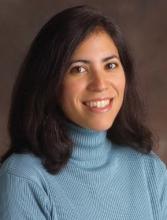Dr. Claudia Geyer wanted to be the best rural doctor she could be, so she completed a residency in family medicine and then another one in internal medicine. Somewhere along the way, she fell in love with inpatient medicine and in 2001 got swept up in the hospitalist movement.
Today, Dr. Geyer is training the next generation of hospitalists. About 5 years ago, she started the 1-year hospital medicine fellowship program at the Central Maine Medical Center, where she trains family physicians and internists who want to be better prepared to be hospitalists. She also chairs the Society of Hospital Medicine’s Family Medicine Committee, a group focused on promoting the advance of family physicians in the field of hospital medicine.
In an interview with Hospitalist News, Dr. Geyer discussed recent trends, training, and recognition of hospitalists trained in family medicine.
Hospitalist News: How many hospitalists working today were trained in family medicine?
Dr. Geyer: To estimate this, we look at membership data from the Society of Hospital Medicine. In 2007, 3.7% of the SHM membership was family physicians. In 2013, it had grown to around 10%. It’s the largest rate increase of any other specialties entering hospital medicine.
HN: Why the growth in the number of hospitalists trained in family medicine?
Dr. Geyer: I think there are two reasons. The first is that a segment of experienced family physicians has leaned toward the hospital side of practice. There are also still many who do both inpatient and outpatient, particularly residency faculty. My sense is that they are self-identifying more as hospitalists if that is their area of focus, and in addition to maintaining a connection to the AAFP (American Academy of Family Physicians), they are also seeing benefit in membership with SHM.
The other factor is that family medicine residents who are exposed to strong inpatient training are choosing to be hospitalists. In recent years, family medicine residency programs have developed areas of concentration in hospital medicine (or hospitalist tracks), and the number of hospital medicine fellowship options for family physicians has quadrupled since we started our program.
HN: In the past, there has been some reluctance to hire hospitalists trained in family medicine as opposed to those trained in internal medicine. Is that feeling changing?
Dr. Geyer: Dr. Swapna Gummadi, Dr. Cindy Rossi, and I actually did a study that we’re presenting in the poster competition at this year’s SHM annual meeting looking at this issue. Dr. Rossi conducted a similar study in 2009 through the Family Medicine Committee. In both cases, we analyzed advertisements for hospitalists to see if the advertisers – individual hospitals, recruiting organizations, and hospitalist organizations – specified whether they wanted internal medicine–trained or family medicine–trained physicians.
In our current study, the majority of organizations were open to hiring hospitalists trained in family medicine.
For the groups that initially said no, we sent a survey asking whether they would consider an applicant who already had hospitalist experience. What if they had received the designation of Fellow in Hospital Medicine? What if they had passed the Recognition of Focused Practice in Hospital Medicine boards? Or what if they had done a 1-year fellowship in hospital medicine? With all of those caveats, we had dramatic changes, on the order of 79% to 100%, from "no" to "yes." And when we compare this information to 2009, it’s an improvement for hospitalists trained in family medicine. We think this reflects a recognition that competency in the field may be earned and recognized with either route of training.
HN: Are there gaps in the training for hospitalists who choose family medicine?
Dr. Geyer: I completed both internal medicine and family medicine residencies, and while there are many similarities, as an internal medicine trainee you have more exposure to the ICU and in-depth medical subspecialty care. As a family medicine trainee, you have more surgical and subsurgical exposure. Training in all of these areas is useful for gaining both the primary and comanagement skills needed by future hospitalists.
The Accreditation Council for Graduate Medical Education last year changed the requirements for family medicine trainees, and they now have a more limited amount of ICU experience required than they did previously. If there’s one thing to point to, family medicine trainees who want to be hospitalists will need to seek additional ICU training.
Internal medicine programs, on the other hand, could benefit from doing more surgical and subsurgical training to enhance comanagement skills similar to family medicine.

